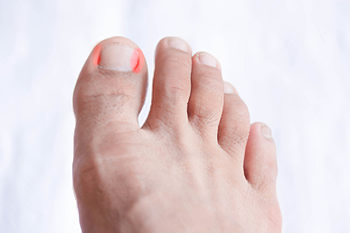How Ingrown Toenails Occur
Tuesday, 08 June 2021 00:00 An ingrown toenail occurs when the toenail curves and grows down into the skin on the sides of the nail. As the toenail digs into the flesh and the flesh grows around it, pain, inflammation, redness, swelling or even an infection can follow. Common factors that lead to ingrown toenails include genetics (such as poor posture, gait, or a deformity), improperly cutting the toenails, and wearing tight shoes. Ingrown toenails are not usually serious. However, they can become very painful and infected if left untreated. If you have diabetes or a compromised immune system, your nail is in persistent pain, or your nail is showing signs of being infected, you should consult with a podiatrist for a proper treatment option.
An ingrown toenail occurs when the toenail curves and grows down into the skin on the sides of the nail. As the toenail digs into the flesh and the flesh grows around it, pain, inflammation, redness, swelling or even an infection can follow. Common factors that lead to ingrown toenails include genetics (such as poor posture, gait, or a deformity), improperly cutting the toenails, and wearing tight shoes. Ingrown toenails are not usually serious. However, they can become very painful and infected if left untreated. If you have diabetes or a compromised immune system, your nail is in persistent pain, or your nail is showing signs of being infected, you should consult with a podiatrist for a proper treatment option.
Ingrown toenails can become painful if they are not treated properly. For more information about ingrown toenails, contact Dr. Eugenio Rivera of Calo Foot & Ankle Specialists. Our doctor can provide the care you need to keep you pain-free and on your feet.
Ingrown Toenails
Ingrown toenails occur when a toenail grows sideways into the bed of the nail, causing pain, swelling, and possibly infection.
Causes
- Bacterial infections
- Improper nail cutting such as cutting it too short or not straight across
- Trauma to the toe, such as stubbing, which causes the nail to grow back irregularly
- Ill-fitting shoes that bunch the toes too close together
- Genetic predisposition
Prevention
Because ingrown toenails are not something found outside of shoe-wearing cultures, going barefoot as often as possible will decrease the likeliness of developing ingrown toenails. Wearing proper fitting shoes and using proper cutting techniques will also help decrease your risk of developing ingrown toenails.
Treatment
Ingrown toenails are a very treatable foot condition. In minor cases, soaking the affected area in salt or antibacterial soaps will not only help with the ingrown nail itself, but also help prevent any infections from occurring. In more severe cases, surgery is an option. In either case, speaking to your podiatrist about this condition will help you get a better understanding of specific treatment options that are right for you.
If you have any questions please feel free to contact our office located in Bellaire, TX . We offer the newest diagnostic and treatment technologies for all your foot and ankle needs.









